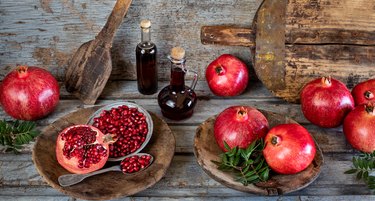
Knowing how to properly dry or dehydrate pomegranate fruits (Punica granatum) is an important first step in using this round red fruit as a lasting, seasonal decoration and in dried floral arrangements. In fact, you can also grow your own pomegranates indoors or outside in U.S. Department of Agriculture plant hardiness zones 8 through 10. In spite of being among the more succulent fruits, pomegranates tend to dehydrate well when prepared correctly. Once they are dry, you can add the pomegranates to your home's décor or decorate them for a more formal effect.
Dried Pomegranate Decoration
Video of the Day
Select whole, fresh pomegranates that are smooth and firm. Make sure there is no sponginess or bruising on the rinds. Puncture the rind multiple times with a sharp toothpick or a pin, but avoid piercing the rind in a way that places the holes too close together, as this may cause the fruit to split. The finished result will be more attractive if this is done in vertical and parallel patterns, rather than in a random fashion.
Video of the Day
Place the pomegranates on a wire rack, and allow them to air dry for three weeks or more. If you do not have a rack, lay them on a baking sheet lined with wax paper. If you choose this method, be sure to turn the fruit over every two to three days to ensure that the pomegranates dry evenly. Once dry, the pomegranates should be about one-third their original size, more brownish pink than red and feel very light compared to the fresh fruits.
If you have access to one, use a large food dehydrator (often found in natural food stores) to help dry the pierced pomegranates. Check the manufacturer's recommendations for the recommended temperature and drying time for a dried pomegranate. Whole fruits will take longer to dry than the seeds, but will dry uniformly and in a fraction of the time they would take to air dry.
Dried Pomegranate Decoration
Place the dried pomegranates in a bowl with pinecones, nuts, apples and evergreen branches for decoration. For a more festive look, gild the pomegranates with metallic gold (or silver) spray paint. The gilded pomegranates will stand out among the natural colors of the other items in the decorative bowl.
Permit your creativity to flow as you explore different ways to showcase your dried pomegranates around your home. Attach the dried pomegranates to an ornamental evergreen wreath with floral wire for décor that will be appropriate from late September through early January.
Dried pomegranates are more fragile than their fresh versions. Avoid allowing them to be crushed or broken when stored between holidays. Several of them can be placed together in a large mason jar or place in an ornament case or plastic storage box. Add silica packets to help absorb any excess moisture your dried pomegranate decoration may emit or attract while awaiting the next holiday season.
Dehydrate Pomegranate Seeds
In addition to decorating, you can harvest the pomegranate seeds and dehydrate them for use in cooking or to enjoy as a tasty and healthy snack. When you harvest the seeds, wear gloves and cover the table with a disposable plastic tablecloth, as the juice will stain everything it touches.
Cut off the top of a ripe pomegranate fruit, then slice along one side. Put the fruit in a bowl of water, then gently pull the rind apart to reach the plump, juice-filled arils that contain the seeds. Carefully roll the sections between your fingers to release the arils. Discard the rind and spongy interior.
Place the seeds in a single layer on the dehydrator mesh rack. Set the temperature at 125 degrees Fahrenheit or at the manufacturer's recommended temperature. Dehydrate for 12 to 14 hours, or until the seeds are dry to the touch and crunchy when you taste test one. Eat as is or store in a tightly sealed container to use later as a snack or on top of yogurt, salads or your morning cereal.